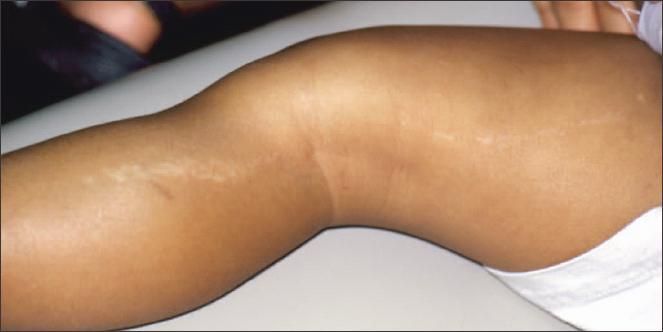Lichen Striatus on the Leg of a 3-Year-Old Boy
This self-limited unilateral dermatitis of unknown cause usually affects preschool children.1-3 Girls are 2 to 3 times more frequently affected than boys.4 The eruption consists of flat-topped pink or flesh-colored papules with a fine scale that form a linear band of less than 1.2 cm in width. It often follows the lines of Blaschko and may extend the entire length of an extremity.

FigureThis slightly scaly, hypopigmented streak on the right medial leg of a 3-year-old boy had been present for several months. It was asymptomatic. The boy was referred to a dermatologist who diagnosed lichen striatus from the clinical presentation; no biopsy specimen was obtained.
This self-limited unilateral dermatitis of unknown cause usually affects preschool children.1-3 Girls are 2 to 3 times more frequently affected than boys.4 The eruption consists of flat-topped pink or flesh-colored papules with a fine scale that form a linear band of less than 1.2 cm in width. It often follows the lines of Blaschko and may extend the entire length of an extremity.
The differential diagnosis includes inflammatory linear verrucous epidermal nevus, linear lichen planus, linear psoriasis, and linearly arranged verruca plana.4 However, the clinical presentation is often so unique that in most cases it is not necessary to refer the patient to a dermatologist, and skin biopsy is rarely required.
Lichen striatus is typically asymptomatic and spontaneously resolves, leaving normal skin pigmentation, after a few weeks to months (as was the case in this child), although it may persist up to 3 years. In patients with excessive associated inflammation, a medium-strength corticosteroid ointment may be considered. Otherwise, reassurance that the condition is benign and temporary is the only treatment necessary.
References:
- Kennedy D, Rogers M. Lichen striatus. Pediatr Dermatol. 1996;13:95-99.
- Taieb A, el Youbi A, Grosshans E, Maleville J. Lichen striatus: a Blaschko linear acquired inflammatory skin eruption. J Am Acad Dermatol. 1991;25:637-642.
- Zhang Y, McNutt NS. Lichen striatus. Histological, immunohistochemical, and ultrastructural study of 37 cases. J Cutan Pathol. 2001;28:65-71.
- Paller AS, Mancini AJ, eds. Hurwitz Clinical Pediatric Dermatology: A Textbook of Skin Disorders in Childhood and Adolescence. 3rd ed. Philadelphia: Elsevier; 2006:72.
Recognize & Refer: Hemangiomas in pediatrics
July 17th 2019Contemporary Pediatrics sits down exclusively with Sheila Fallon Friedlander, MD, a professor dermatology and pediatrics, to discuss the one key condition for which she believes community pediatricians should be especially aware-hemangiomas.